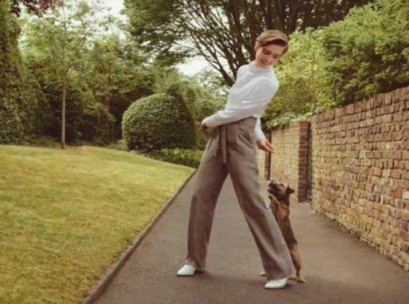 When Amazon officially launched its own fashion line, Find, in the UK earlier this month, it received a warm reception from some of the industry’s most influential voices. Harper’s Bazaar UK called the collection “fashion forward”, while Cosmopolitan UK deemed it “pretty damn cool”.
When Amazon officially launched its own fashion line, Find, in the UK earlier this month, it received a warm reception from some of the industry’s most influential voices. Harper’s Bazaar UK called the collection “fashion forward”, while Cosmopolitan UK deemed it “pretty damn cool”.
With men’s and women’s fashion and footwear ranging from around £35 (A$60) for jeans and £52 (A$88) for boots, Find has positioned itself alongside millennial favourites, such as ASOS and Topshop. And while it’s still early days, many analysts think it will do well in the space.
Find is not only noteworthy for its surprisingly stylish apparel offering, it is also emblematic of Amazon’s huge, and increasingly sophisticated, investment in private label products across a vast range of categories.
“In the past two years, Amazon has rolled out upwards of 20 private label brands in categories spanning from clothing to baby to bedding. Some of these brands, like AmazonBasics and Amazon Elements, have Amazon in the name, but most of the new brands don’t, like Happy Belly and Lark & Ro,” writes Julia Millot, a market research analyst at 1010data, which analysed Amazon’s private label sales from January to June of this year.
“With an 80 per cent [year-on-year] growth rate, Amazon’s private labels pose a real challenge to traditional brands across hundreds of categories,” Millot writes.
Overall, Amazon’s private label products account for just two per cent of total units sold on Amazon in the first half of 2017, but, as Millot notes, some individual brands have shown enormous growth.
Batteries, baby wipes to bras
Amazon’s biggest private label line, AmazonBasics, brought in over US$200 million in sales during the first half of 2017. The brand, which sells nearly 2,000 products from batteries to pots and pans, was the ecommerce company’s first private label line. Today, AmazonBasics batteries reportedly represent nearly a third of all online battery sales in the US.
Next up, comprising 55 per cent of all Amazon private label sales, is the company’s own brand electronics, including Kindle, Echo, Fire TV and Kindle Fire, which saw sales of over US$75 million in the first half of 2017.
In third place is Amazon Elements, which started selling baby wipes in 2014 and this year expanded to a variety of health-related items including supplements. It earned US$9.5 million during the first half of 2017.
Amazon’s top ten most popular private label products today are all technology-related, but more than half of their private label brands now sell clothing, according to 1010data.
Indeed, these are some of Amazon’s fastest-growing private label brands. Children’s clothing line, Scout + Ro experienced the most aggressive year-on-year growth, shooting up over six-fold in the first half of 2017. Meanwhile, Franklin & Freeman, a men’s shoe line, and Lark & Ro, a women’s clothing line, also experienced healthy growth, increasing sales by 153 per cent and 84 per cent, according to 1010data.
US market research firm, L2, agrees that Amazon’s private label fashion brands have been gaining traction, particularly men’s dress shirt brand Buttoned Down, which currently has products ranking in the top 20 ‘best sellers’ for the category.
L2 noted in a July article about Amazon Prime Day that the company almost exclusively featured its own private label brands, including Buttoned Down, women’s lingerie brand, Mae, and men’s casual clothing brand, Goodthreads, in the fashion deals section, helping to drive consumer awareness.
Meanwhile, New York-based investment banking firm, Cowen and Company, predicted nearly two years ago that Amazon would soon become the biggest apparel seller in the US, outpacing Macy’s.
It expects Amazon to generate US$62 billion in annual apparel sales by 2021, ahead of TJ Maxx, which it expects will generate US$26 billion in sales, and Macy’s, which it expects will generate US$23 billion in sales.
Trojan horses
Mihir Kittur, co-founder and CEO of analytics firm Ugam Solutions tells IRW that Amazon is now doing around US$3 billion in private label sales a year.
And it’s not just the sheer number of Amazon’s private label brands that has Australian retailers worried, according to Kittur. It’s Amazon’s ecosystem of devices, like Alexa, and services, like Prime Wardrobe, a try-before-you-buy service currently being trialled, which make the company’s private label proposition so hard to beat.
“Conventional retailers look at private label as an assortment and a way to attract customers through the value of private label. But Amazon is not doing private label in the conventional sense,” he says, referring to the company’s strategy as a “flywheel”, a mechanical device that stores energy as it rotates, so it can keep spinning without requiring much additional energy.
“They give you great value and make it very convenient and you give them so much data that they are able to provide a tremendous amount of relevance.”
Looking at Prime Wardrobe, Kittur says Amazon will use the Trunk Club-like service to get insight into buying patterns. It can refine its understanding of what sells and what doesn’t by nudging customers with specific images and products, and feed the findings into its manufacturing.
“It helps [Amazon] become smarter with anticipating the market. How they then blend it with the supply chain will be interesting to see,” Kittur says.
“We saw them push very hard on next-day delivery. They’re trying to really push the envelope of cycle time on apparel. Imagine if they were able to further drive the margins for apparel to five days.”





